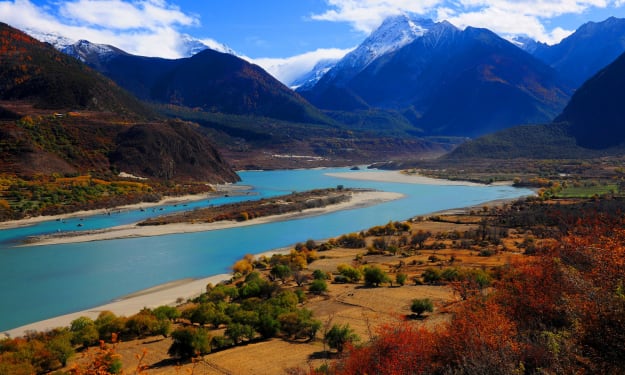The Dance of Sun and Moon
A Celestial Symphony

The celestial bodies that grace our sky with their radiant presence, the Sun and the Moon, have captivated human imagination and curiosity since time immemorial. These luminous orbs, seemingly disparate in their characteristics, play integral roles in shaping our world and influencing life on Earth. In this article, we embark on a journey to explore the fascinating relationship between the Sun and the Moon, delving into their unique attributes, cultural significance, and the mesmerizing dance they perform in the cosmic ballet.
I. The Sun: A Cosmic Powerhouse
A. The Solar Dynamo:
At the heart of our solar system reigns the sun, a colossal ball of hot, ionized gas that provides the primary source of light and energy for Earth. With temperatures reaching millions of degrees Celsius at its core, the sun's intense nuclear fusion reactions release an immense amount of energy in the form of light and heat. This solar dynamo not only sustains life on our planet but also governs the rhythm of the natural world.
B. Sunspots and Solar Flares:
The sun's surface is adorned with dark spots known as sunspots, which are cooler regions caused by magnetic activity. These sunspots ebb and flow in cycles, influencing solar activity. Occasionally, the sun unleashes powerful bursts of energy in the form of solar flares, captivating astronomers and reminding us of the dynamic nature of our closest star.
The Moon: Earth's Mysterious Companion
A. Lunar Mystique:
The Moon, Earth's only natural satellite, has long been a source of wonder and inspiration. Its phases, from the waxing crescent to the waning gibbous, create an ever-changing celestial tapestry. The moon's presence in the night sky has sparked myths, legends, and cultural significance across diverse civilizations.
B. Tidal Forces:
One of the moon's most palpable effects on Earth is its control over tides. The gravitational pull exerted by the Moon creates tidal bulges in Earth's oceans, resulting in the rhythmic rise and fall of tides. This lunar influence not only shapes coastlines but also affects ecosystems and marine life.
III. The Dance of Shadows: Solar and Lunar Eclipses
A. Solar Eclipses:
When the moon aligns perfectly between the earth and the sun, a solar eclipse unfolds. This rare and awe-inspiring event occurs when the moon casts its shadow on Earth, temporarily obscuring the sun. Witnessing a total solar eclipse is a breathtaking experience, as day turns to night for a brief moment, revealing the intricate dance of these celestial bodies.
B. Lunar Eclipses:
Conversely, a lunar eclipse occurs when the Earth passes between the Sun and the Moon, casting its shadow on the lunar surface. The moon takes on a reddish hue during a total lunar eclipse, earning it the poetic moniker "blood moon." These celestial displays have evoked wonder and fear throughout history, often interpreted as omens or divine messages.
IV. Cultural Significance and Mythology
A. Solar Deities:
Across cultures and civilizations, the sun has been revered as a deity symbolizing life, vitality, and enlightenment. From Ra in ancient Egypt to Helios in Greek mythology, the sun has played a central role in religious and cultural narratives.
Lunar Symbolism:
The moon, with its ever-changing phases, has been associated with cycles of life, death, and rebirth. In various mythologies, lunar deities such as Selene, Chang'e, and Tsukuyomi embody the mystical and transformative qualities attributed to the moon.
V. Scientific Exploration and Discoveries
A. Solar Observations:
Advancements in telescopic technology and space exploration have allowed scientists to study the sun in unprecedented detail. Solar observatories and spacecraft like the Solar Dynamics Observatory (SDO) provide crucial insights into solar phenomena, contributing to our understanding of the sun's impact on space weather and Earth's climate.
B. Lunar Exploration:
The moon has also been a focal point of exploration efforts. Human missions, such as the Apollo program, brought astronauts to the lunar surface, unveiling the mysteries of our celestial neighbor. Ongoing robotic missions continue to unravel the Moon's geological history and potential for future scientific endeavors.
Conclusion:
The Sun and the Moon, though vastly different in nature, share an intricate relationship that shapes the very fabric of our existence. From their profound scientific influences to their rich cultural symbolism, these celestial entities continue to inspire awe and wonder. As we gaze upon the heavens, let us appreciate the enduring dance of the Sun and Moon—a celestial symphony that transcends time and connects us to the cosmic wonders of our universe.
About the Creator
prasanna sundar
Fitness is a holistic pursuit, combining physical exercise, balanced nutrition, and mental well-being. Regular exercise, a nutritious diet, and mindfulness practices contribute to overall health.






Comments (1)
Awesome 🥰